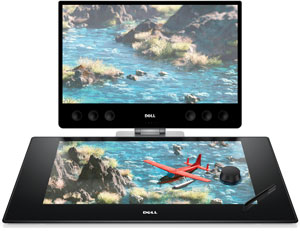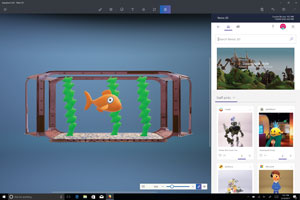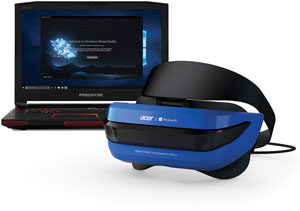In-Depth
Windows 10 Creators Update and the Evolution of the Universal Windows Platform
While Windows 10 Creators Update primarily aims to please professionals and content creators, it also ratchets forward the Universal Windows Platform.
Microsoft's second major Windows 10 upgrade will figuratively and literally change the way users look at PCs, devices and games powered by the OS -- at least for those inclined.
Windows 10 Creators Update, which Microsoft started pushing out to consumers last month, is scheduled to arrive for business and enterprise customers this summer. IT pros will welcome some important security and management features, but unlike the last update, those are in the background for all intents and purposes.
At first glance, Creators Update might not look all that different, either. Aside from some incremental UI changes, it resembles the current Anniversary Edition release from last summer. Beneath the surface, however, the hallmark of the Creators Update is its ability to let users create and render visual images in distinct new ways with the new Paint 3D, enhanced digital ink and what Microsoft calls "mixed-reality" holograms supported by a coming wave of headsets from its major PC partners and eventually the company's own HoloLens.
Microsoft is heavily promoting the idea that last month's release is the first version of Windows focused on creating, rather than consuming, information and content. This aspect is so pronounced that the Creators Update arguably represents the first release that makes Windows a viable alternative to the Apple Mac OS among creative and engineering types, while aiming to appeal to young computer users and those who feel Apple has fallen behind.
"We designed Windows 10 to empower the creator in all of us," said Yusef Mehdi, corporate VP of the Windows and Devices Group at Microsoft, in a post announcing the release. "To us, that means that everyone has the power to dream big, whether that involves starting a company, developing a lesson plan, inventing a product, developing or broadcasting games, or imagining a whole new world in Minecraft or mixed reality [MR]."
Speaking at a developers' update event back in February, Terry Myerson, who heads the Windows and Devices Group as executive VP, argued that the "Creators Update really does break new ground for Windows [by] enabling people to capture, create, print and share in 3D." Myerson also emphasized the Creators Update support for interactive 4K video offered in a growing number of new high-end displays and PCs, such Microsoft's new Surface Studio, among others.
New Visual Rendering
While Microsoft is hoping that the Creators Update support for 3D images, more natural digital inking via substantially added inputs and interfaces, and MR holograms will fire up those who are now ambivalent about Windows, the company is also counting on a crop of new immersive PCs, displays and high-end peripherals from major PC suppliers to create demand and new usage models by consumers and professionals alike.
Microsoft has rallied both traditional and up-and-coming software partners to take advantage of the Creators Update digital inking, 3D and MR features. Traditional computer-aided design (CAD) and professional illustration tool providers climbing aboard include Adobe Systems Inc., Autodesk Inc., Corel Corp., Siemens PLM Software, SolidWorks Corp. and Trimble Inc. Among the newer partners are BlueBeam Inc., Drawboard Pty Ltd., Mental Canvas and StaffPad Ltd.
The aim is to stimulate use of different forms of input such as the new Surface Dial, a silver input device shaped like a hockey puck, paving the way for new forms of content creation and aiding in critical tasks, such as engineering, modeling, manufacturing, medicine and creating new experiences in retail. While the Surface Dial today only works with the Surface Studio, Surface Pro 4 and Surface Book systems from Microsoft, it's a safe bet it will ultimately work with other systems. Partners such as Dell Inc. have their own alternatives, such as the new Dell Canvas, a 27-inch display driven by an alternative to the Dial, what Dell calls totem (see Figure 1).
 [Click on image for larger view.]
Figure 1. The Dell Canvas is a 27-inch display that lets designers and engineers create 3D content and works with any PC running Creators Update.
[Click on image for larger view.]
Figure 1. The Dell Canvas is a 27-inch display that lets designers and engineers create 3D content and works with any PC running Creators Update.
3D Paint and Natural Inking
Perhaps the most obvious new feature is the traditional Paint tool, a longtime feature in Windows, now supports 3D. Microsoft aptly calls it Paint 3D. Those who use the inking features will find that it offers more inputs and provides ink analysis, which analyzes ink stroke input for Windows Ink apps, such as shape detection and recognition, handwriting recognition, and layout interpretation and classification. A new Ink toolbar in Creators Update enables the new Ink Canvas, and new support for Input injection programmatically generates and automates input from a variety of devices. Developers can specify inking apps via the updated Ink Workspace. Any Paint 3D user can tap the online community of Remix3D (see Figure 2).
 [Click on image for larger view.]
Figure 2. Paint 3D lets users create or convert graphics into 3D objects and includes access to a library of images from the online Remix3D.com community.
[Click on image for larger view.]
Figure 2. Paint 3D lets users create or convert graphics into 3D objects and includes access to a library of images from the online Remix3D.com community.
The new creation and visual-rendering capabilities in Creators Update also certainly aim to attract designers and to give a boost to Microsoft's growing PC gaming franchise. And now that Xbox shares the same Windows code base, Microsoft is hoping the update will start bringing gaming across device types.
Microsoft believes Creators Update will usher in a new wave of use cases for computing by businesses, individuals and gamers alike at a time when there are various OS options. It remains to be seen if those who have never craved these features are moved or merely see them as catchy gimmicks.
"My experience has been that there is a long list of nice improvements, but nothing game-changing," says Billy Hollis, a UX expert with Memphis-based consulting firm Next Version Systems. "The 3D stuff will light up some people, but I think the average Windows user won't really know what to do with it. I like it because I have two HoloLens devices, so anything that starts to flesh out 3D capabilities is interesting to me."
Of course, not everyone has access to HoloLens; the headsets running Windows 10 that Microsoft calls the first holographic computers are still in preview and cost around $3,000. Hollis will be giving an introduction on how to develop apps for the MR headsets at this month's Visual Studio Live! conference in Austin, produced by Redmond magazine parent company 1105 Media Inc.
"Devices like this will bring 3D holographic content right into our world, enhancing the way we experience life beyond our ordinary range of perceptions. I'm not thinking about a distant future, I'm talking about today," said Alex Kipman, a Microsoft Technical Fellow spearheading the company's HoloLens and MR development efforts, in a TED talk in February, where he gave a surreal presentation of HoloLens and Microsoft's vision for MR. "We are already seeing car companies like Volvo designing cars differently with HoloLens, universities like Case Western redefining the way medical students learn and, my personal favorite, NASA is using HoloLens to let scientists explore planets holographically."
MR Headsets for Consumers
While HoloLens is targeted at high-end business and scientific and industrial use cases, the Creators Update will also bring MR to the mainstream with consumer headsets expected to arrive later this year from Acer Inc., ASUSTeK Computer Inc., Dell, HP and Lenovo. Acer was the first to introduce a headset based on Microsoft's MR interfaces during a Microsoft-hosted session at the Game Developers Conference (GDC) held in San Francisco in March. Microsoft is including the Acer headsets with its own MR toolkit, including the SDKs to enable developers to build MR applications.
 [Click on image for larger view.]
Figure 3. The Acer Windows Mixed Reality Development Edition headset includes two high-res 1440x1440 displays.
[Click on image for larger view.]
Figure 3. The Acer Windows Mixed Reality Development Edition headset includes two high-res 1440x1440 displays.
Microsoft claims the new MR headsets are plug-and-play and are the first to provide built-in inside-out tracking, thereby not requiring users to purchase external trackers or wall sensors. The Acer MR headsets (see Figure 3) include two high-resolution 1440x1440 LCD displays with a refresh rate of up to 90Hz (native), built-in audio output, a 3.5mm jack for a microphone, and an HDMI 2.0 cable for display and support for USB 3.0 data connectivity, according to the specs published by Microsoft.
Desktop Focus on Universal Windows Platform
Whether your organization is the first to jump on the HoloLens bandwagon, or you start playing with one of the more modest $300 headsets, or simply take advantage of the 3D inking and new input options, the new Creators Update release will also showcase the Windows Store and the Universal Windows Platform (UWP). Behind the scenes leading up to this release, Microsoft has also taken aim at making the UWP more viable for the next generation of software, with the clock ticking on existing traditional Win32 apps. Microsoft's ability to bridge those apps to the UWP and the Windows Store will be critical.
By introducing 3D and MR to Windows, and by extension Office, Microsoft is hoping demand will motivate developers to build UWP apps. In making its case, Microsoft cites estimates that the 3D industry will grow by more than 62 percent in the next three years. "We want to empower everyone to experience, create and share in 3D with the Creators Update," Mehdi noted.
"I think the desktop is getting sexy again," says John Bristowe, principal developer advocate at the Telerik unit in Progress Software Corp. and a Microsoft MVP. "The desktop has, unfortunately, been forgotten a bit. People use browsers most of the time, but if you start to look at what's available for the desktop, people realize they've been missing out a little bit. That's part of the reason why you're seeing updates like this, and UWP is part of that vision."
Microsoft's acquisition last year of tools maker Xamarin, which is now included in its Visual Studio developer toolset, promises to play a critical role, adds Bristowe's colleague Sam Basu, a developer advocate at Telerik and also a Microsoft MVP. "With UWP, Microsoft has better play with enterprises and lines of business, which can all be UWP apps and be able to run on all of these devices. But when you talk from a developer standpoint, things don't need to be hard-core UWP only," Basu points out. "If I'm doing Xamarin development, for example, that's cross-platform mobile. It still uses .NET. I could also target UWP as a platform, and then I have a code base that runs apps on iOS, Android and UWP, which really covers everything. And UWP as a platform is Microsoft's bet and they are going to go all out on it."